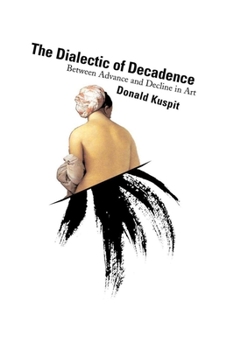The Dialectic of Decadence
In The Dialectic of Decadence, Kuspit disentangles misconceptions of decadence generated by the notion of advance in art. He asserts that any attempt in modern art to renounce expressionism and the pursuit of meaning in figurative art is in itself a result of discontentment and decadence--a loss of faith in history to tell its own story. Using a psychoanalytic approach, Kuspit topples Minimalist decrees most forcefully expressed by Donald...
Format:Paperback
Language:English
ISBN:1581150520
ISBN13:9781581150520
Release Date:April 2000
Publisher:Allworth
Length:128 Pages
Weight:1.30 lbs.
Dimensions:0.3" x 6.0" x 9.0"
Customer Reviews
1 rating
Don't Diddle Declares Kuspit
Published by Thriftbooks.com User , 23 years ago
It can be read in several hours. It can be studied for several more. And it can be thought about for days on end. Donald Kuspit's The Dialectic of Decadence (129 pp.) is actually a republished essay. "Essay" comes from the French word "to try," and Kuspit does try to lay out the problems of contemporary art. We get to try to figure it out with him, since the book provides plenty of information besides the long essay: wonderful notes (themselves a concise education in art and esthetics), photos of the art mentioned in the book, and two Afterwords, one recently written by the author as an update. Kuspit's theory is suggested in the subtitle of the book: Between Advance and Decline in Art. To quote a sentence from the Afterword: "In decadence, creativity ends neither with a bang nor a whimper, but with ideology, intimidation, and megalomania." Against the jingoism of much of the contemporary debate, with its Puritanism and ego-tripping, Donald Kuspit comes out strongly against narrowness, and for wholeness in creativity.Such a wish is not exactly a new idea. What makes his wish so potent is the discerning way he sets it up. Calling on Freud, Semiotics, art critics, artists, knowledge of art history, and photographs of art, Kuspit lays out the historic development of the contemporary battle between (dialectic of) control and desire, between intellectualization and expressiveness. "In modernity, art remains fundamentally divided against itself, separating into semioticizing superegoistic and desiring expressive parts..."Well, that takes care of Freudian and postmodern biases in one swoop! Usually however, Kuspit writes in a style that, while learned, is much more readable than much art writing. Although some of the ground he covers is not easy, he writes with clarity and without the dense prose of, say, ARTFORUM. Readers will have to bring their brains, but not dictionaries nor tolerance for a self-consciously erudite writer. Kuspit clarifies the "dialectic of decadence" of the title by using examples. Donald Judd is the representative of high abstraction, with Sandro Chia and Baselitz Judd's main whipping boys. Judd becomes the bad guy, a prime example of dogmatic ideology. Kuspit quotes Judd (as he "enhances his own work") by linking Chia, Baselitz, and other artists to the dreaded "decadence." Here's Judd: "The public doesn't know, for example, that after Kirchner and Nolde, whom probably they don't know by name, there have been hundreds of painters flailing Expressionism, so that when they see Baselitz whipping a dead horse they expect it to stand up, or at least roll over." Kuspit also points out that the other side, figurative and/or expressive art, enters the dialectic by flinging at ideological art the barb "advanced abstraction is socio-communicatively inadequate." The book would have a pox on both their houses, although it is mostly upset with Judd. The author claims that each sect in art today is a




